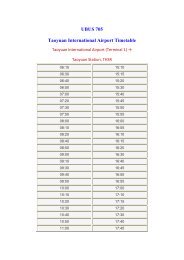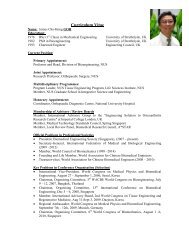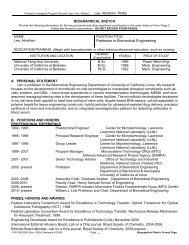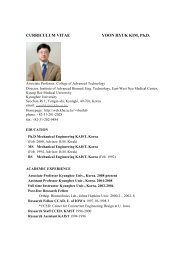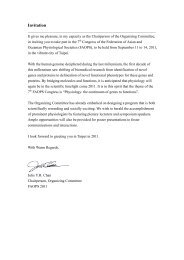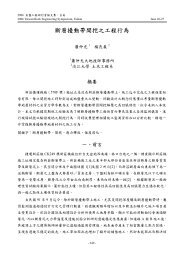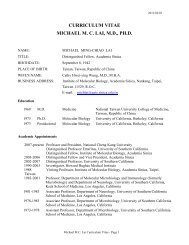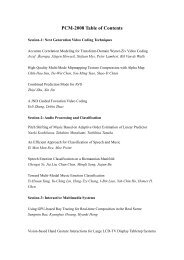<strong>Research</strong> <strong>Express@NCKU</strong> - <strong>Articles</strong> <strong>Digest</strong><strong>Research</strong> <strong>Express@NCKU</strong> Volume 6 Issue 2 - October 17, 2008[ http://research.ncku.edu.tw/re/articles/e/20081017/6.html ]In Vivo Optical Biopsy and MolecularMicrotomography Imaging UsingNanoparticle ProbesShih-Peng Tai 1 , Yana Wu 2 , Tze-Ming Liu 1 , Chien-Huei Chang 2 , Xuan-Yu Shi 2 , Kuan-Jiuh Lin 3 , Chi-Kuang Sun 1 , Dar-Bin Shieh 2,4,5,*1 Department of Electrical Engineering and Graduate Institute of Photonics and Optoelectronics,National Taiwan University2 Institute of Oral Medicine and Institute of Basic Medical Sciences, National Cheng KungUniversity3 Department of Chemistry, National Chung Hsing University4 Department of Stomatology, National Cheng Kung University Hospital5 Institute of Basic Medical Sciences, National Cheng Kung UniversityEmail:dshieh@mail.ncku.edu.twAdvanced Materials 2007 19: 4520-4523.Optic Express 2006, 14(13)6178-6187Pathological diagnosis has long been recognized as the ultimate standard of diseasediagnosis. However, the clinical biopsy process is usually uncomfortable and at risk forcomplications such as bleeding, tissue trauma, seeding of malignant cells and so on forthe patient. For clinical doctors, selection of appropriate site for correct pathologicaldiagnosis of disease could be a challenge when dealing with multiple or large lesions.Recent advancement of non-invasive medical imaging technology has provided betterspatial resolution of anatomical details and molecular information of diseases. For example, highmagnetic field MRI imaging technology combined advanced coil design and imaging pulse sequence wasable to approach a spatial resolution of around hundred micrometers. However, all these imagingtechnologies still failed to reach a cellular or sub-cellular level of resolution. In a series of reports, wehave developed non-invasive, stain/label free, high resolution in vivo tomographic virtual biopsy systemthrough endogenous non-linear optical properties of biological molecules and histological structures. Ina following research, we have advanced the system with molecular imaging capability using the nonlinearoptical property of targeting-probe-conjugated nanoparticles.Third-harmonic-generation (THG) has been emerged as an important noninvasive intravital imagingmodality of in vivo biological research in recent years with the advantages including intrinsic opticalsectioning capability due to the high order nonlinearity nature and no energy release due to the virtualstate-transitioncharacteristic, thus allowing much improved cell viability in contrast to currentabsorption based fluorescence technologies. Harmonic generation imaging also provides high spatialresolution in tomography and therefore provide 3D structural information of the whole lesion andadjacent tissues. A great potential in the future development of this technology in the clinical diagnosticimaging and stem cell research that required minimal stimulation to the cells are expected.Previous harmonic generation imaging mostly used forward transmission mechanism and thus limited1 of 6
<strong>Research</strong> <strong>Express@NCKU</strong> - <strong>Articles</strong> <strong>Digest</strong>their clinical applications. We modified our optical design for backward mechanism and used Cr:forsterite laser as the light source. A pair of galvano mirror was used to control the X-Y scanning of thefiled. A pair of PMT was used to pick up the photon signal. For long time in vivo observation of theanimal model, we have integrated anesthesia and body temperature control to keep vital signs inphysiological range during imaging acquisition process (figure 1).Figure 1. Schematic illustration of the higher harmonic generation imagingacquisition system (http://www.opticsinfobase.org/abstract.cfm?&uri=oe-14-13-6178).Molecules with repetitive structures usually exhibit strong second harmonics optical property. Theseinclude many biomolecules such as cytoskeleton, collagen, elastin, etc. It is conceivable that harmonicgeneration imaging could well be applied for molecular topographic imaging for biomolecules in thetissue. In addition, although THG nonlinearity exists in all bio-materials, the Gouy phase shift effectsubstantially limits THG to be observed in the vicinity of interfaces where the first order or third ordersusceptibility discontinues. Therefore, THG is generally regarded as a morphological imaging for cellularstructures such as special domains in cellular membrane, nucleus, etc. The following figure presents aseries of tomographic in vivo imaging for normal oral mucosa (left) versus oral cancer lesions (right) in alive hamster by harmonic generation optical system (Figure 2). The blue channel in the images camefrom third harmonics signals and mostly distributed in the intercellular junction of normal oral mucosalepithelium. The green fibrous structure was collected from the second harmonic signals from collagenfibers in the dermis. The image quality provided more detailed information for the orientation, density,and distribution of the fibers compared to traditional H&E stain in pathological sections. On the onehand, collagen could only be visualized in deeper tissue and usually intermingled with cancerous cells incancer lesions. Prominent nucleoli and peri-nuclear granular structures could be clearly identified in the2 of 6



